Whether it’s due to a lack of respect or fear, a horse’s refusal to move forward on the trail is frustrating and can turn dangerous.
Some horses get in the habit of stopping in the middle of the trail and refusing to go forward. They will either stick their feet in the ground and stand still or actually run backwards.
A horse that suddenly stops and runs backwards usually does it for one of two reasons:
1) He may do it because of a lack of respect, which means that your “go” button isn’t good enough. When you cue him forward with your legs, he doesn’t respect you.
2) He may do it because of a lack of confidence. You might be coming up on an object or obstacle that scares him and causes him to back away from it.
In both instances, however, the more you try to get the horse to go forward, the more he will resist you or want to back up. You’ll be able to tell if your horse is stopping out of a lack of respect or fear by the way he behaves. A horse that is truly fearful of something will be on high alert—his head will be raised in the air, he’ll feel tense, he may snort and be fidgety. If he’s stopping out of a lack of respect, he won’t exhibit any of those signs. Instead, he’ll have the demeanor of an errant employee slipping out the back door to sneak a smoke break.
If the cause is the horse’s fear of an object or obstacle that lies ahead, use the to build his confidence in the situation and eventually get him to pass the object or go across the obstacle.
If your horse is stopping out of fear, no amount of trying to prod him forward will fix the problem. In fact, the more you urge him forward, the more fearful and resistant he’ll become. If your horse is stopping out of a lack of respect, here are some suggestions for addressing the problem and fixing it.

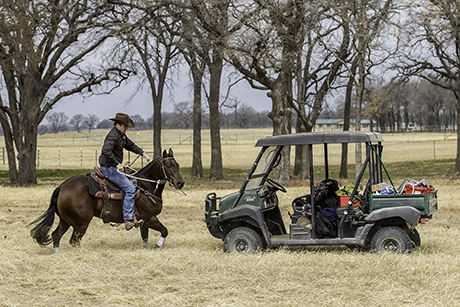
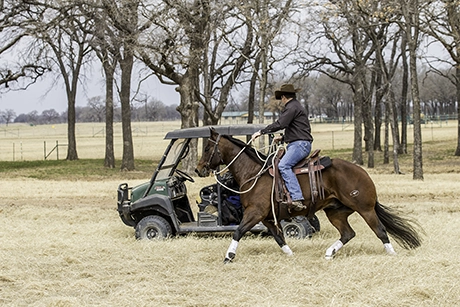
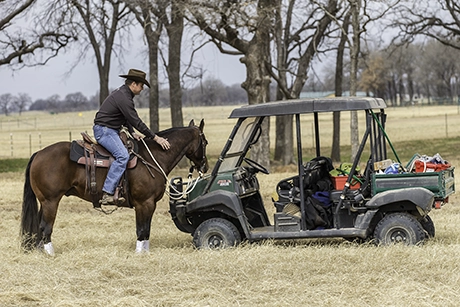
If a spooky object on the trail ahead is the cause of your horse’s reluctance to move forward, use the Approach and Retreat Method to build his confidence and get him to confidently approach the object.
Practice Cruise Control
If your horse regularly stops and runs backwards on the trail, it is entirely possible that he doesn’t have a very good gas pedal to begin with. In other words, it’s a clear sign that you skipped your homework. Before riding your horse on the trail, you should have spent time in the arena practicing the Cruising Lesson, and then, once you started riding him outside of the arena, you should have practiced Controlled Cruising and Confused Loping. Your best bet would be to get to work in the arena and improve his respect for your legs. When you ask him to go by gently squeezing his sides with the calves of your legs, he should willingly move forward until you ask him to stop.
Back and Back Some More
If you are out on the trail and the horse wants to stop and back up, take his negative energy and turn it into a positive. Ask him to back! Turn his idea into your idea. Don’t back him so aggressively that you pull really hard on the reins and cause him to flip over backwards. But back him up—a lot. Keep backing him up for some time after he is willing to stop.
If your horse is far enough along in his training, do not just back him in a straight line. Back him in circles or practice backing angles. The more you make him focus by redirecting his feet and giving him something to think about, the faster you’ll fix the problem.
Many people will back the horse for 10 or 15 feet and then ask him to go forward. That’s not enough of a correction to make an impact. Back the horse up for 200 or 300 feet. Back the horse until he doesn’t really want to back up any more. It’s funny how when it’s your idea to do something it’s no longer fun for your horse. After backing him, bend him around your leg in a few circles to soften him up. Then ask him to trot straight forward.
If you come to a place where the horse hits the brakes and runs backwards again, repeat the exercise. Go backwards with him. Back him up until he doesn’t want to back any more. Then back him up a little farther.
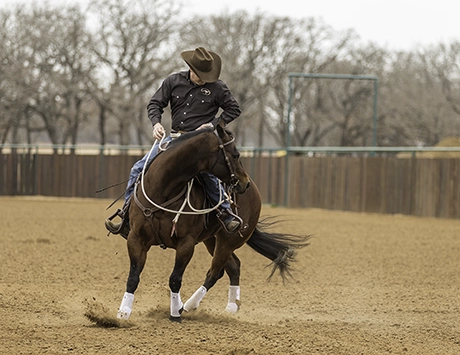
If your horse is stopping on the trail because he doesn’t respect your cues to move forward, it’s a clear sign you need to go do your homework in the arena. Practice transition exercises, such as Yield to a Stop, as I’m doing here, and the Cruising Lesson.
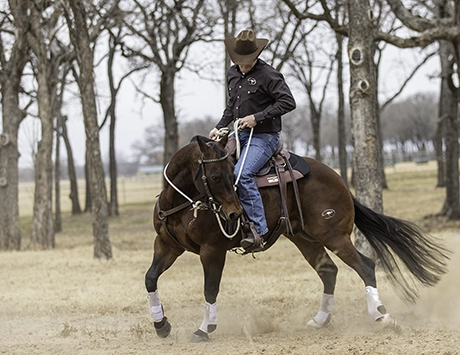
Turn your horse’s idea into your idea: If he backs up, ask him to back up. Then hustle his feet in a few circles.
When you are done backing, turn the horse in a few small circles. Bend him around your leg and get his feet moving before heading straight off at a trot.
Sometimes bending the horse around your legs and freeing his feet up is enough to get him going forward again. The key, of course, is to get control of his feet and get the horse using the thinking side (rather than the reactive side) of his brain, which is what all of the Fundamentals exercises and the foundation trail exercises at the beginning of this series are designed to do
If the horse is really disrespectful as he backs up, you may feel safer working him from the ground. That’s fine: Get off and put him to work. Back him up for 500 feet, if that’s what it takes. But back him with energy. Get him really lifting his feet and shifting his weight back to his hindquarters. And, again, if he’s far enough along in his training, don’t just hustle him backwards in a straight line. Back him in angles or in circles—make him really focus on what you’re asking him to do.
Then, before you get back in the saddle, doublecheck his “go” button by practicing some Lunging for Respect Stage Two. As soon as you point with your hand to tell the horse to move, he should hustle his feet out onto the circle. If he doesn’t, use the end of your mecate to make him feel uncomfortable for ignoring you. A good rule of thumb to remember is if your horse has an attitude about moving forward when you work with him on the ground, or he’s lazy, his response is only going to get worse under saddle.
What you’re doing with the horse in this situation is making the right thing easy and the wrong thing difficult. The horse needs to realize that you can back him up all day—and that backing is MUCH more difficult than calmly going forward. Once you have addressed the horse’s lack of respect and his lack of confidence, his refusal to go forward on the trail should become a thing of the past.
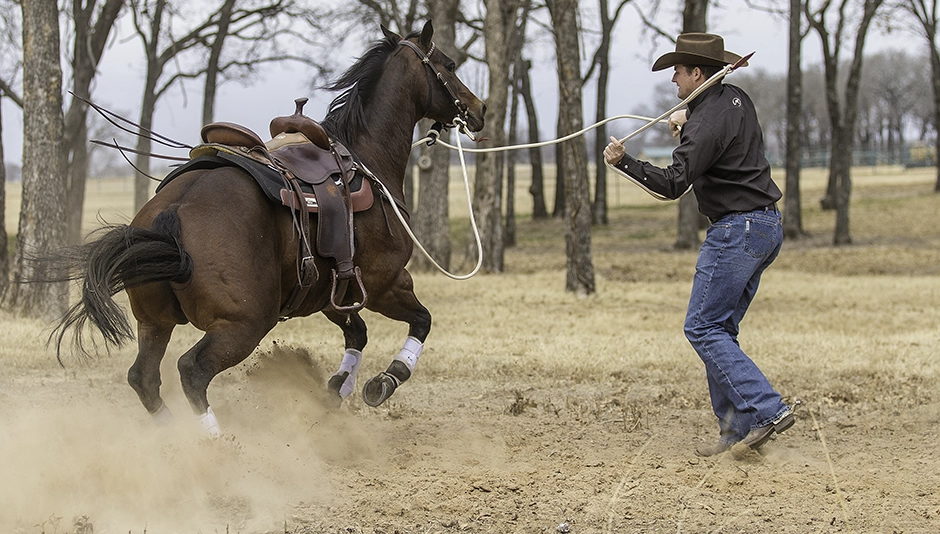
If you feel more confident handling the problem from the ground, you can incorporate the same fix that you would under saddle. Make those feet move with energy!
Success Tip:
Don’t be in a hurry.
Riding on the trail is fun, and everyone wants to get out of the arena as fast as they can, but don’t be in such a hurry to leave the arena that you set your horse up to fail. Review those minimum requirements I listed at the beginning of the series. At the very least, you should spend three weeks working with your horse in the arena, teaching him the Fundamentals, before taking him on the trail. If you’re dedicated to following the recipe I’m laying out for you, you’ll run into very few problems. And the problems you do run into will require minimal effort to fix. However, if you rush through your horse’s training or do a poor job of preparing him for a ride, I guarantee you’ll run into trouble. Every. Single. Time. Take the time that it takes to establish a great foundation on your horse. That’ll set you up for years of trail riding fun.

Master Your horsemanship Skills
Like these tips? Join the No Worries Club and hone your skills with thousands of hours of Clinton’s easy, step-by-step method horse training videos.



